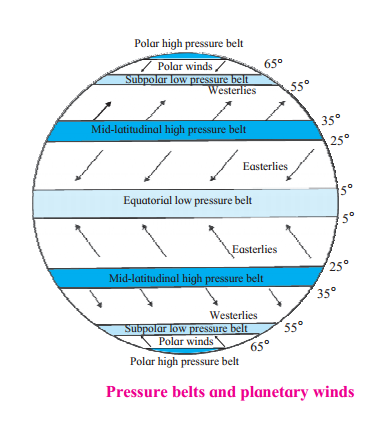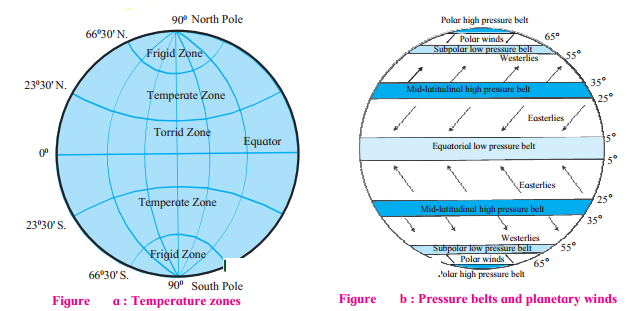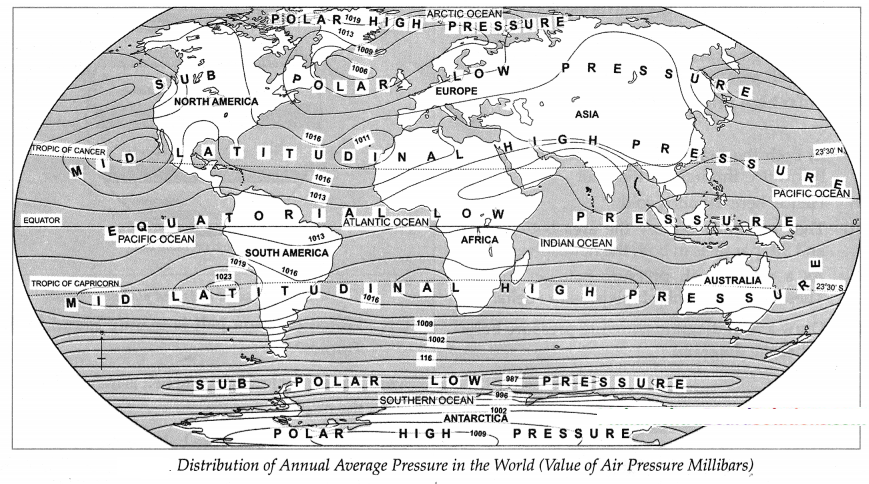Balbharti Maharashtra State Board Class 7 Geography Solutions Chapter 4 Air Pressure Notes, Textbook Exercise Important Questions and Answers.
Std 7 Geography Chapter 4 Question Answer Air Pressure Maharashtra Board
Class 7 Geography Chapter 4 Air Pressure Question Answer Maharashtra Board
Air Pressure Class 7 Questions And Answers
1. Give reasons:
Question 1.
Air pressure decreases with increasing altitude.
Answer:
- The proportion of dust in the air, water vapour, heavy gases, etc. is higher in the air and closer to the surface of the earth.
- This proportion decreases with increasing altitude.
- As one moves higher and higher from the surface of the earth, the air becomes thinner and thinner.
- As a result, the air pressure decreases with increasing altitude.

Question 2.
Pressure belts oscillate.
Answer:
- The duration and the intensity of sunrays varies during particular periods of the year in both the hemispheres.
- So, the locations of the temperature zones and the pressure belts dependent on the sun’s heat also vary.
- This change is of the order of 5° to 7° towards the north in Uttarayan1 and 5° to 7° south in Dakshinayan2.
- In this way pressure belts oscillate.
2. Give short answers to the following questions.
Question 1.
What effect does temperature have on air pressure?
Answer:
- Temperature and air pressure are closely related. Wherever the temperature is high, the air pressure is low.
- As the temperature rises, the air gets heated, expands, and becomes lighter.
- This lighter air in the vicinity of the earth’s surface starts moving up towards the sky
- As a result, the air pressure in such areas decreases.
Question 2.
Why is the subpolar low pressure belt formed?
Answer:
- Due to earth’s curvature, the area between two parallels gets reduced as we move towards the poles.
- This results in lesser friction1 of the air with the earth’s surface.
- Air in this region is thrown out because of this reduced friction and also because of the earth’s rotational motion.
- This leads to the development of a low pressure belt in the sub polar region i.e. in area between 55° & 65° parallels in both the hemispheres.
3. Write notes on:
Question 1.
Mid-latitudinal high pressure belts.
Answer:
- The heated air from the equatorial region becomes lighter, starts ascending and after reaching higher altitudes, moves towards the polar region, i.e., towards the North and the South Pole.
- Due to low temperatures at the higher altitudes, the air cools down and becomes heavier.
- This heavier air descends down in both the hemispheres in the region between 25° to 35° parallels.
- This leads to the formation of high pressures, belts in these parallels of latitudes in both the hemispheres.
- This air is dry, hence the region does not get rainfall.
- Consequently, most of the hot deserts on the earth are found in these regions.

Question 2.
Horizontal distribution of air pressure.
Answer:
- The heat received from the sun is uneven in different regions.
- The distribution of temperature is uneven from the equator to the poles.
- This difference can lead to difference in air pressure.
- There are four air pressure belts formed on the earth surface.
- Equatorial low-pressure belt between 5°N and 5°S parallels as the temperature is high here.
- Mid latitudinal high-pressure belt between 25° and 35° parallels due to descending heavier air.
- Subpolar low-pressure belt formed between 55° and 65° parallels due to friction and rotation.
- Polar high-pressure belt formed between 80° and 90° parallels due to low temperatures.
4. Fill in the gaps with the appropriate option.
Question 1.
At higher altitudes air becomes ________. (thicker, thinner, hotter, more humid)
Answer:
thinner
Question 2.
Air pressure is expressed in _______ .(millibars, millimeters, milliliters, milligrams)
Answer:
millibars
Question 3.
On the earth, air pressure is _______.(uniform, uneven, high, low)
Answer:
uneven
Question 4.
The ______ pressure belt spreads between 5° North and 5° South parallel. (equatorial low, polar high, subpolar low, mid-latitudinal high)
Answer:
equatorial low
5. How does a high-pressure belt get formed near 30 ° parallel? Why does this region have hot deserts?
Answer:
(i) The heated air from the equatorial region becomes lighter, starts ascending and after reaching higher altitudes, moves towards the polar region, i.e., towards the North and the South Pole.
(ii) Due to low temperatures at the higher altitudes, the air cools down and becomes heavier. This heavier air descends down in both the hemispheres in the region between 25° to 35° parallels.
(iii) This leads to the formation of high pressures belts in these parallels of latitudes in both the hemispheres.
(iv) This air is dry, hence the region does not get rainfall. Consequently, most of the hot deserts on the earth are found in these regions.
6. Draw a neat diagram showing pressure belts. Label the diagram.
Answer:

Class 7 Geography Chapter 4 Air Pressure InText Questions and Answers
Formative Assessment
Can you tell?
Observe the diagram Fig. (a) and (b) carefully and answer the following questions:

Question 1.
Which pressure belt is mainly found in the Tropics?
Answer:
Equatorial low pressure belt is mainly found in the tropics.
Question 2.
With which pressure belt are the polar winds associated? In which temperature zone are they observed?
Answer:
The polar winds are associated with polar high pressure belt and sub polar low pressure belt. It is observed in the frigid zone.

Question 3.
What could be the reason behind a low pressure belt in the Tropics?
Answer:
Low pressure belt is formed in the tropics because the temperature is high.
Question 4.
With which pressure belts are the winds in the Temperate zone associated?
Answer:
The winds in temperate zone are associated with mid latitudinal high pressure belt.
Question 5.
Write the latitudinal extent of the low pressure belts.
Answer:
The latitudinal extent of Equatorial low pressure belt is between 50°N & 50°S parallel & the latitudinal extent of the sub polar low pressure belt is between 55° & 65° parallel in both the hemispheres.
Observe the map given above and study the distribution of air pressure and answer the following

Question 1.
The nature of the isobars.
Answer:
The isobars are joining places of equal air pressure on the map.
Question 2.
High and low pressure belts and their latitudinal position.
Answer:
(i) The latitudinal position of high pressure belt is between 25° & 35° parallels and between 80° & 90° parallels in both the hemisphere
(ii) The latitudinal position of low pressure belt is between 0° & 5° parallels and between 55° & 65° parallels in both the hemispheres.
Question 3.
The direction of the isobars and the distance between successive isobars over the oceans and continents.
Answer:
(i) In the northern hemisphere most of the isobars are in southwest to north east direction over the continents. Also the distance between the isobars varies.
(ii) Closely spaced isobars indicate large pressure changes over a small area. Widely spaced isobars indicate gentle or gradual pressure change.
(iii) In the southern hemisphere, the isobars extend in east-west direction. The distance between the isobars is fairly constant over the oceans & so the isobars are fairly parallel to each other.

Question 4.
Comparison of the isobars in the northern and the southern hemispheres.
Answer:
In the northern hemisphere the isobars are far spaced and uneven, whereas in the southern hemispheres it is closely spaced and parallel.
Use your brainpower !
Question 1.
If there is low pressure at the equator, what will be the condition of air pressure in the Arctic Zone?
Answer:
The Arctic zone will experience high pressure as the temperature is lower than 0°C.
Try this:
Question 1.
- Take a flying lantern.
- Tie an approximately 5m long thread to the flying lantern so that you can bring the lantern down whenever required.
- After carefully reading the instructions given on the package of the lantern open it and light the candle placed in it.
- After some time, bring the lantern down with the help of the thread and put off the candle.
Question 2.
Did the flying lantern start ascending immediately after the candle was lit?
Answer:
Yes
Question 2.
What would have happened to the flying lantern had the candle got extinguished after the lantern had gone up in the air?
Answer:
The lantern would have fallen back on the earth.
Give it a try:
Question 1.
Study the temperative distribution map given in your std VI textbook and the pressure distribution map in this lesson to find the correlation between air temperature and air pressure.
Answer:
- The temperature deceases continuously from the equator to the poles but the air pressure varies alternately.
- In the equatorial region the average temperature is high. Hence, the air pressure is low.
- In the polar regions, the temperature is low & hence the air pressure is comparative high.
Class 7 Geography Chapter 4 Air Pressure Additional Important Questions and Answers
Fill in the blanks choosing the correct option from the bracket:
Question 1.
Pressure belts oscillates between ______ parallels. (5° to 7°, 10° to 20°, 80° and 90°, 25° to 30°)
Answer:
5° to 7°

Question 2.
The instrument used to measure air pressure is ______ .(barometer, thermometer, hygrometer, seismometer)
Answer:
barometer
Question 3.
In both the polar regions, the temperature is below ________ throughout the year. (5°C, 0°C, 7°C, 6°C)
Answer:
0°C
Question 4.
The line that joins the places of equal pressure on the map is called an _______. (isotherm, isohytes, millibars, isobar)
Answer:
isobar
Match the following:
Question 1.
| A (Pressure Belt) | B (Parallels) |
|
(1) Sub Polar low pressure
(2) Mid latitudinal high pressure (3) Polar high pressure (4) Equatorial low pressure |
(a) 25° to 35°
(b) 5°N and 5°S (c) 55° to 65° (d) 80° to 90° |
Answer:
1 – c
2 – a
3 – d
4 – b
Fill in the blanks:
Question 1.
The latitudinal extent of the temperate zones is much _____ while belts are narrower.
Answer:
Larger
Question 2.
The extent of air pressure belt is upto ______ parallel.
Answer:
10°
Question 3.
Pressure belts are formed between the _______ and the pole.
Answer:
Equator
Question 4.
The sun rays fall perpendicular between the ______and ________.
Answer:
Tropic of Cancer, Tropic of Capricorn
Question 5.
Due to the earths curvature, the area betweentwo parallels gets ______ as we move towards the poles.
Answer:
reduced
Question 6.
The air pressure at sea level is ______ millibars.
Answer:
1013.2

State whether the following statements are true or false:
Question 1.
Air pressure is uniform on all places on the earth’s surface.
Answer:
false
Question 2.
Whenever the temperature is high, the air pressure is also high.
Answer:
false
Question 3.
The heat received from the sun, is uneven in different regions.
Answer:
true
Question 4.
In both the polar regions, the temperature is low throughout the year.
Answer:
true
Question 5.
Air pressure is measured in units of millimetres.
Answer:
false
Answer the following questions in one to two sentence:
Question 1.
Which factors influence air pressure?
Answer:
The altitude of a region, temperature of the air and the amount of water vapour in the air are some factors influencing air pressure.
Question 2.
What is the extent of air pressure belt?
Answer:
The extent of air pressure belt is generally upto 10° parallel.
Question 3.
What is the latitudinal extent of temperate zone?
Answer:
The latitudinal extent of temperate zone is from 23°30’N to 66°30’N and 23° 30’S to 66° 30’S.
Question 4.
What is the temperature in the polar region?
Answer:
In both the polar regions, the temperature is below 0°C throughout the year.
Question 5.
Why do all things in and on the earth stay earth bound?
Answer:
All things in and on the earth stay bound due to the earth’s gravity.
Question 6.
Why are temperature zones created on the surface of the earth?
Answer:
The heat received from the sun is uneven in different regions. Hence the distribution of the temperature is uneven from the equator to the poles. As a result, temperature zones are created.
Question 7.
Most of the hot deserts on the earth are found in which region?
Answer:
Most of the hot deserts on the earth are found in the mid latitudinal high pressure belt ie; between 25° to 30° parallels in both hemispheres.

Give reasons:
Question 1.
Air pressure is maximum at sea level.
Answer:
- All things in and on the earth stay earthbound because of the earth’s gravity. This includes air which is in the gaseous form.
- Due to the earth’s gravity, air is pulled to the earth’s surface.
- Also as one moves higher & higher from the earth’s surface the air becomes thinner & thinner.
- Therefore, the air pressure is maximum at sea- level.
Question 2.
A low pressure belt is formed near the equator.
Answer:
- The sunrays can be perpendicular between the Tropic of Cancer and the Tropic of Capricorn.
- The temperature is higher in this region.
- Hence air in this region gets heated, expands and becomes lighter and moves towards the sky.
- As this process operates continuously, a low pressure belt gets formed in the central part of this region between the parallels 5° N and 5° S, near the equator.
Question 3.
High pressure belt is formed near the polar region.
Answer:
- In both the polar regions, the temperature is below 0° throughout the year.
- The air is cold.
- Hence, high pressure belt is formed in the polar region.
Question 4.
Low pressure belt is observed between 55° and 65° parallels in both the hemispheres.
Answer:
- Due to the earth’s curvature, the area between two parallels gets reduced as we move towards the poles. This results in lesser friction of the air with the earth’s surface.
- The air between 55° and 65° parallels is thrown out because of the reduced friction and also due to the earth’s rotation.
- Therefore, a low pressure belt is observed between 55° and 65° parallels in both the hemispheres.
Question 5.
Temperature and air pressure are closely related.
Answer:
- Wherever the temperature is high, the air pressure is low. As the temperature rises the air gets heated, expands, and become lighter.
- Thin, lighter air in the vicinity3 of the earth’s surface starts moving up towards the sky. As a result the air pressure in such area decreases.
- Hence, temperature and air pressure are closely related.
Question 6.
Most of the hot deserts on the earth are found in mid-latitudinal high pressure belts.
Answer:
- The air in mid-latitudinal high pressure belt (between 25° to 35° parallels in both hemisphere) is found to be dry.
- The amount of water vapour is very low & hence this region gets extremely scarce or no rainfall.
- Consequently, most of the hot deserts on the earth are found in mid latitudinal high pressure belts.
Give short answers to the following questions:
Question 1.
What are the effects of air pressure?
Answer:
Air pressure has the following effects.
- Origin of winds.
- Generation of storms
- Convectional type of rain.

Question 2.
What is the difference between the temperature zones and pressure belts?
Answer:
(i) The difference between the temperature zones & pressure belts is that the latitudinal extent of temperature zones is much larger while pressure belts are narrower.
(ii) For example, the Temperate zone extends from 23°30′ to 66°30′ in both hemisphere. Compared to this the pressure belt has limited extent which is generally upto 10° parallel.
(iii) Also the temperature zones are continuous & spread from the equator to the poles from Torrid to Frigid.
(iv) Pressure belts are not continuous & areas of high & low pressure are found in different regions from the equator to the poles.
Question 3.
How does a high pressure belt get formed near 30° parallel? Why does this region have hot deserts?
Answer:
(i) The heated air from the equatorial region becomes lighter, starts ascending and after reaching higher altitudes, moves towards the polar region, i.e., towards the North and the South Pole.
(ii) Due to low temperatures at the higher altitudes, the air cools down and becomes heavier. This heavier air descends down in both the hemispheres in the region between 25° to 35° parallels.
(iii) This leads to the formation of high pressures belts in these parallels of latitudes in both the hemispheres.
(iv) This air is dry, hence the region does not get rainfall. Consequently, most of the hot deserts on the earth are found in these regions.
Think about it:
Question 1.
What will be the effect on air pressure if the temperature drops? Why?
Answer:
If the temperature drops, the air pressure will increase as the air becomes heavy.